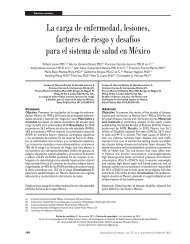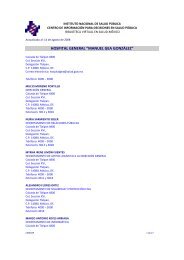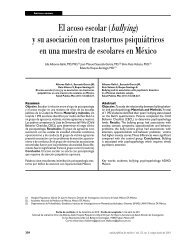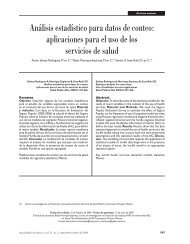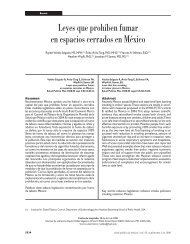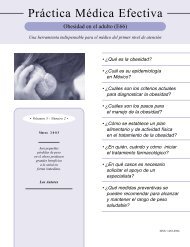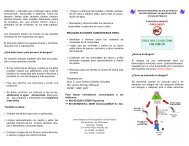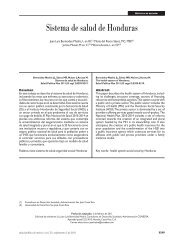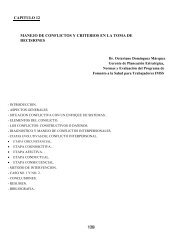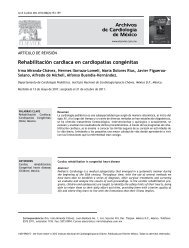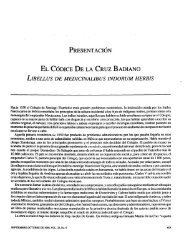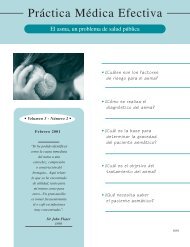Anemia and iron, zinc, copper and magnesium deficiency in ...
Anemia and iron, zinc, copper and magnesium deficiency in ...
Anemia and iron, zinc, copper and magnesium deficiency in ...
You also want an ePaper? Increase the reach of your titles
YUMPU automatically turns print PDFs into web optimized ePapers that Google loves.
M<strong>in</strong>eral <strong>deficiency</strong> <strong>in</strong> Mexican adolescents Ar t í c u l o orig<strong>in</strong>Al<br />
Body <strong>iron</strong> (mg/kg)<br />
12<br />
10<br />
8<br />
6<br />
4<br />
12 14 16 18 20<br />
Age (years)<br />
95% CI Female Male<br />
fi g U r e 1. ef f e c t o f a g e o n t o t a l b o D y i r o n b y s e x <strong>in</strong><br />
me x i c a n a D o l e s c e n t s. ensanUt 2006<br />
Discussion<br />
We present evidence here<strong>in</strong> for a high prevalence of <strong>iron</strong>,<br />
<strong>z<strong>in</strong>c</strong>, <strong>copper</strong> <strong>and</strong> <strong>magnesium</strong> deficiencies <strong>in</strong> Mexican<br />
male <strong>and</strong> female adolescents. Females were more prone<br />
to suffer most of m<strong>in</strong>eral deficiencies. When compar<strong>in</strong>g<br />
the prevalence of LIS <strong>in</strong> female adolescents <strong>in</strong> the<br />
NNS-99 with those here<strong>in</strong> reported, there is a decrement<br />
<strong>in</strong> the prevalence (40.5% vs 18.4%). 9,20 However,<br />
methodological differences may confound such a big<br />
decrease; <strong>in</strong> 1999 LIS was assessed by percent saturation<br />
of transferr<strong>in</strong>, while <strong>in</strong> 2006 a direct measurement<br />
of s-ferrit<strong>in</strong> was used.<br />
The puberty onset is probably critical to enhance<br />
the sexual differences <strong>in</strong> TBI <strong>in</strong> this study, i.e. a larger<br />
growth of muscle mass <strong>in</strong> males 21 <strong>and</strong> losses of <strong>iron</strong><br />
throughout menstruation results <strong>in</strong> larger TBI <strong>in</strong> males<br />
relative to females. Information on population based<br />
estimates of TBI are scanty; data from NHANES III<br />
reported <strong>in</strong> adults older than 20 years mean TBI values<br />
of 9.89 ± 2.82 mg/kg for males <strong>and</strong> 4.87 ±4.14 mg/kg for<br />
females, 14 similar to those reported here<strong>in</strong>. We are aware<br />
that Cook’s equation is not validated for adolescents,<br />
however, even if the external validity may be questionable,<br />
the <strong>in</strong>ternal validity allows for valid comparisons<br />
between both genders. We made efforts to homologate<br />
our TfR results to Cook’s laboratory, correct<strong>in</strong>g as by<br />
Ramco’s kit.<br />
In the present study, the majority of cases of anemia<br />
were not expla<strong>in</strong>ed by ID; other nutritional causes of<br />
anemia as such folate <strong>and</strong> vitam<strong>in</strong> B12 deficiencies were<br />
not evaluated. 22 However, the adequacy of the dietary<br />
<strong>in</strong>take of vitam<strong>in</strong> B12 was 110%, while the adequacy<br />
for folate was 70%. This may expla<strong>in</strong>, <strong>in</strong> part, the high<br />
salud pública de méxico / vol. 54, no. 2, marzo-abril de 2012<br />
proportion of non IDA. Both, low <strong>and</strong> excessive <strong>copper</strong><br />
serum concentrations are associated with IDA. 4,23 In our<br />
study, adolescents with anemia had significantly higher<br />
serum concentrations of <strong>copper</strong> than their non anemia<br />
counterparts, <strong>in</strong> l<strong>in</strong>e with the reported by NHANES-II. 4<br />
The association between <strong>iron</strong> <strong>and</strong> <strong>copper</strong> deficiencies<br />
is most probably due to the role of <strong>copper</strong> as a cofactor<br />
of <strong>iron</strong> oxidiz<strong>in</strong>g prote<strong>in</strong>s as such hefast<strong>in</strong> <strong>and</strong> ceruloplasm<strong>in</strong>e.<br />
24<br />
The possibility of subestimat<strong>in</strong>g ID as a cause of<br />
anemia could be <strong>in</strong>fluenced by acute <strong>in</strong>fections <strong>and</strong><br />
<strong>in</strong>flammation. However, the rate of acute <strong>in</strong>fections<br />
at this age is low. 25 We used a 6 mg/L cut-off for CRP,<br />
<strong>in</strong>stead of the usual 3 mg/dL, because <strong>in</strong> a segmented<br />
regression model us<strong>in</strong>g data from two probabilistic<br />
surveys <strong>in</strong> Mexican population (n=5 000) the <strong>in</strong>flexion<br />
po<strong>in</strong>t for ferrit<strong>in</strong> values occurred at a concentration of<br />
6 mg/L of CRP (data not published).<br />
Low serum <strong>copper</strong><br />
The lack of population-based studies on <strong>copper</strong> status<br />
<strong>in</strong> adolescents prevents from an adequate comparison<br />
of our data. The prevalence of low <strong>copper</strong> concentrations<br />
among adolescent girls from Sudan was 5.9%; 26<br />
<strong>in</strong> Iranian pre <strong>and</strong> postmenopausal women was 17%; 27<br />
<strong>in</strong> Chilean adults the prevalence was 8.6% <strong>in</strong> males <strong>and</strong><br />
5.9% <strong>in</strong> females. 28 The prevalence of low serum <strong>copper</strong><br />
<strong>in</strong> our series is one of the highest <strong>in</strong> the literature.<br />
The rarity <strong>and</strong> letality of genetic diseases associated<br />
with <strong>copper</strong> deficiencies as such Menkes disease <strong>and</strong><br />
aceruloplasm<strong>in</strong>emia 29,30 make difficult to <strong>in</strong>voke them<br />
as significant causes of this large proportion of LSC.<br />
It is possible that the higher <strong>copper</strong> requirement dur<strong>in</strong>g<br />
the puberty growth spurt dra<strong>in</strong>s <strong>copper</strong> out of the<br />
circulation. 30<br />
Z<strong>in</strong>c <strong>deficiency</strong><br />
The prevalence of <strong>z<strong>in</strong>c</strong> <strong>deficiency</strong> <strong>in</strong> female adolescents<br />
here<strong>in</strong> reported was similar to that <strong>in</strong> NNS-99 (29.7%).<br />
The overall prevalence was higher than reported for<br />
developed countries but lower than for develop<strong>in</strong>g<br />
countries. In American children 9-19 years of age, the<br />
prevalence was 1% for males <strong>and</strong> 1.3% for females. 31 In<br />
British children 11-14 <strong>and</strong> 15-18 years of age the prevalence<br />
of <strong>z<strong>in</strong>c</strong> <strong>deficiency</strong> for boys was 0 <strong>and</strong> 2%, <strong>and</strong> for<br />
girls 2 <strong>and</strong> 5% respectively. 7 Prevalence <strong>in</strong> Nepalese<br />
females 13-35 years of age, varied from 78 to 90%. 32 The<br />
Mexican prevalence here<strong>in</strong> reported is lower than for<br />
Southeast Asia (71.2%), Africa (68%), East Mediterranean<br />
(73.5%) <strong>and</strong> the Americas (45.8%) but higher than<br />
for the West Pacific (18.6%) <strong>and</strong> Europe: 8.0%. 1<br />
143



